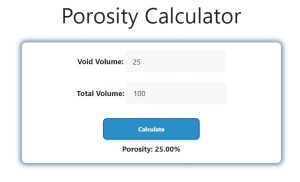About Porosity Calculator (Formula)
Porosity is a key property in materials science and engineering that measures the fraction of void space (empty space) in a material. This is essential in fields like geology, hydrology, and construction, where understanding the porosity of materials like soil, rocks, or concrete can impact decisions on resource extraction, water flow, or structural strength. The Porosity Calculator helps in determining the porosity percentage by comparing the volume of voids (empty spaces) to the total volume of the material.
Formula
The formula to calculate porosity is:
Porosity = (Vv / Vt) × 100
Where:
- Vv = Volume of voids (empty space within the material)
- Vt = Total volume of the material
How to Use
- Determine the Volume of Voids (Vv): Measure or estimate the volume of voids within the material. This is the space that is not occupied by solid matter.
- Determine the Total Volume (Vt): Measure the total volume of the material, including both solid matter and voids.
- Apply the Formula: Divide the volume of voids by the total volume and multiply by 100 to get the porosity percentage.
Example
Suppose you are analyzing a rock sample with a total volume of 100 cm³, and you estimate that the volume of voids (empty space) within the rock is 25 cm³. The porosity would be:
- Porosity = (25 / 100) × 100
- Porosity = 0.25 × 100
- Porosity = 25%
This means 25% of the rock’s volume consists of empty space or voids.

FAQs
- What is porosity?
Porosity is the percentage of void spaces or empty spaces within a material relative to its total volume. - Why is porosity important?
Porosity is critical in understanding the permeability of materials, influencing factors like fluid flow, material strength, and resource extraction. - What units are used in porosity calculations?
Porosity is a dimensionless percentage. The volumes of voids and total material are typically measured in cubic centimeters (cm³), cubic meters (m³), or liters (L), but any volume unit can be used as long as they are consistent. - What is a high porosity material?
A high porosity material has a larger proportion of empty spaces, such as pumice stone or loose soil, allowing more air or fluid to pass through. - What is a low porosity material?
Low porosity materials, like granite or dense metals, have fewer voids, meaning less air or fluid can pass through them. - How does porosity affect permeability?
Higher porosity generally increases permeability, allowing fluids to flow through the material more easily. However, the size and connectivity of the voids also play a significant role. - Can porosity exceed 100%?
No, porosity cannot exceed 100% because void spaces are always a fraction of the total volume. - Is porosity always measured in percentages?
Yes, porosity is usually expressed as a percentage, though it can also be represented as a fraction or decimal (e.g., 0.25 or 25%). - How is porosity related to soil or rock type?
Porosity varies depending on the type of material. For example, sandy soils have higher porosity than clay soils, while porous rocks like sandstone have higher porosity than dense rocks like basalt. - What industries use porosity measurements?
Porosity is crucial in industries like construction, oil and gas exploration, hydrogeology, and environmental engineering. - How is porosity related to density?
A material with high porosity often has a lower density, as a significant portion of its volume is empty space. - Can porosity change over time?
Yes, porosity can change due to factors like compaction, weathering, or the addition or removal of materials within the voids (e.g., fluid flow or sedimentation). - What tools are used to measure porosity?
Tools like pycnometers, mercury intrusion porosimeters, and computed tomography (CT) scans are often used in scientific and industrial settings to measure porosity. - How does porosity impact concrete?
In concrete, porosity affects durability and strength. Lower porosity concrete tends to be stronger and more resistant to weathering and water infiltration. - Can porosity be manipulated during material processing?
Yes, porosity can be altered during the manufacturing or treatment processes, such as in ceramics or concrete production, where compaction or additives can reduce or increase void spaces. - How does porosity affect groundwater movement?
Higher porosity materials allow for better water movement, making them ideal for aquifers, while low porosity materials may restrict water flow. - Can porosity impact thermal conductivity?
Yes, materials with higher porosity generally have lower thermal conductivity, making them good insulators. - What is effective porosity?
Effective porosity refers to the portion of the total porosity that contributes to fluid flow, excluding isolated void spaces. - Can porosity influence oil extraction?
Yes, in oil reservoirs, high porosity can indicate a greater capacity for holding and extracting oil, although permeability is also crucial. - How does porosity affect soil health?
Porosity in soils affects water retention and air flow, both of which are critical for plant root health and nutrient uptake.
Conclusion
The Porosity Calculator is a simple yet valuable tool for calculating the percentage of void spaces in any material. Whether used in geology, engineering, or construction, understanding porosity can inform important decisions about material behavior and performance. With the formula, it becomes easy to determine the porosity and gain insight into how materials will interact with air, water, or other fluids in practical applications.
